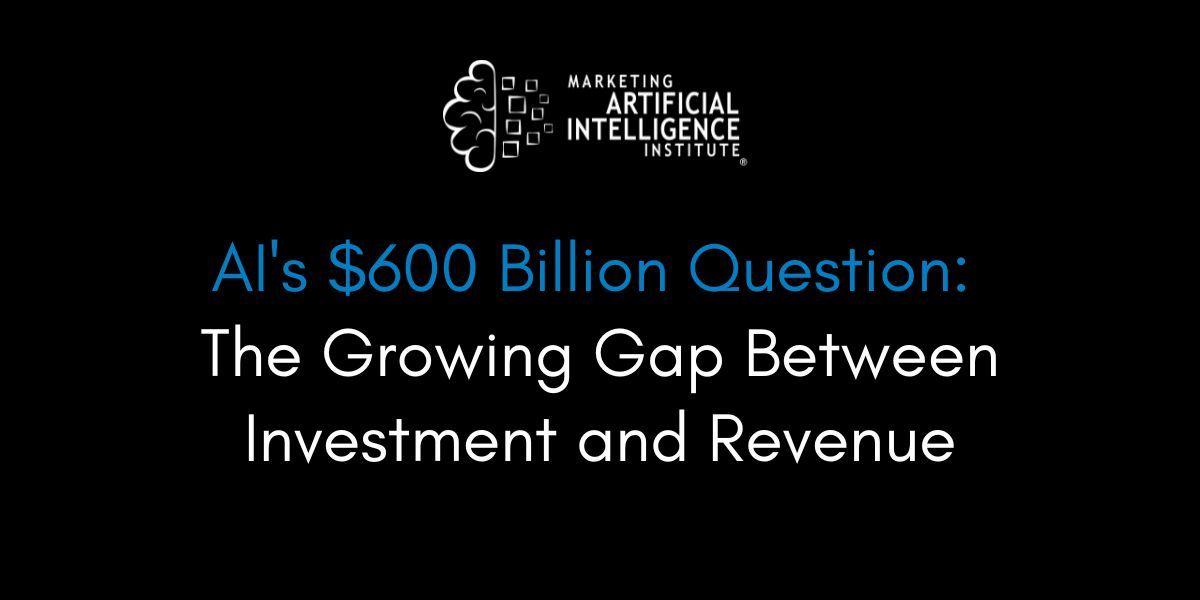The AI industry is facing a significant disconnect between the massive investments in companies and technology—and the actual economic impact of those investments.
That’s the takeaway from a couple new reports from Sequoia Capital and The Economist. Both outlets raise serious questions about whether or not AI is actually living up to the hype.
And Sequoia even puts a number to it, saying that AI needs to fill a $500 billion annual revenue gap to be economically viable.
Are we in an AI bubble?
I got the answers from Marketing AI Institute founder/CEO Paul Roetzer on Episode 104 of The Artificial Intelligence Show.
Sequoia $600-billion question
Sequoia’s skepticism comes from a new report by Sequoia partner David Kahn. In it, he recently updated his analysis of the AI industry's revenue expectations.
According to Kahn's numbers:
- The revenue gap has grown from a $125 billion "hole" to a staggering $500 billion gap that needs to be filled by revenue growth.
- This gap represents the difference between current capital expenditures and the revenue needed to justify those investments.
"They're actually looking at how much money is being spent with NVIDIA, and then how much of that is leading to actual revenue,” says Roetzer, breaking down Sequoia’s logic.
“They're largely looking at product revenue. They're not really factoring in things like cost savings, innovation, productivity."
So, the real question Sequoia is asking comes down to:
How much of the capital expense build-out is linked to true end customer demand, and how much is being built in anticipation of future customer demand?
"And that's a valid question," says Roetzer. Plenty of leading tech companies are buying up AI chips and building data centers on the promise of AI that will, eventually, produce revenue.
“It’s all being done on this promise of eventual consumer demand,” says Roetzer. Sequoia is approaching this through the very specific (and understandable) lens of a VC firm looking to find companies that match their infrastructure investment with a product that actually creates end user value.
“From that premise, it makes a bunch of sense,” says Roetzer. But it’s also a little more nuanced than headlines might have us believe.
Headlines aren’t the whole story
Headlines not telling the whole story certainly seems to be a trend.
The Economist published an in-depth report on the disconnect between AI hype and its actual economic impact. Their reporting suggests that while many companies are experimenting with or heavily investing in AI, there's little evidence of AI boosting productivity on a large scale.
A key part of their argument is a U.S. Census Bureau report from March 2024 that claims AI adoption rates remain surprisingly low—at just 5.4% of businesses in their books (as of February 2024).
"I was kind of shocked by this one,” says Roetzer, finding it extremely low.
So he dug into the numbers and methodology a little more. And, while the Census Bureau's massive sample size of 164,000 businesses initially seems impressive, Roetzer quickly identified several issues with the report.
For one, the questions asked to get at AI adoption numbers were unclear.
The survey asked if businesses used AI in "producing goods and services," which Roetzer points out is “not the same as AI adoption,” neglecting possible AI usage in areas like marketing, HR, or accounting.
Also, the person being asked about AI matters.
The Bureau doesn’t appear to have identified who within an organization is the best person to ask about AI.
“You could bias this data by people just not being sure what [the Census Bureau] is asking,” says Roetzer. Not everyone within a company knows what AI is or knows how it’s being used.
As a result, it’s not valid to say AI adoption is only a touch above 5%.
The reality of AI adoption
So, what's the real story when it comes to AI adoption and impact?
"I think it's probably within reason that 5% or less of companies have an actual AI roadmap, change management plan, internal academy, AI council, and are really scaling AI," says Roetzer.
But piloting AI technology is a different animal entirely.
“I think there’s a much higher number where people or teams or departments within organizations are experimenting with it, trying to figure it out, testing technology, and testing use cases,” he says. “That [in my experience] is prevalent."
So, while the headlines might paint a picture of slow AI adoption and questionable returns on investment, the reality is likely more nuanced.
There may indeed be a gap between current investments and realized value. But the true impact of AI is likely still unfolding—and may be more significant than some reports suggest.
Mike Kaput
As Chief Content Officer, Mike Kaput uses content marketing, marketing strategy, and marketing technology to grow and scale traffic, leads, and revenue for Marketing AI Institute. Mike is the co-author of Marketing Artificial Intelligence: AI, Marketing and the Future of Business (Matt Holt Books, 2022). See Mike's full bio.



